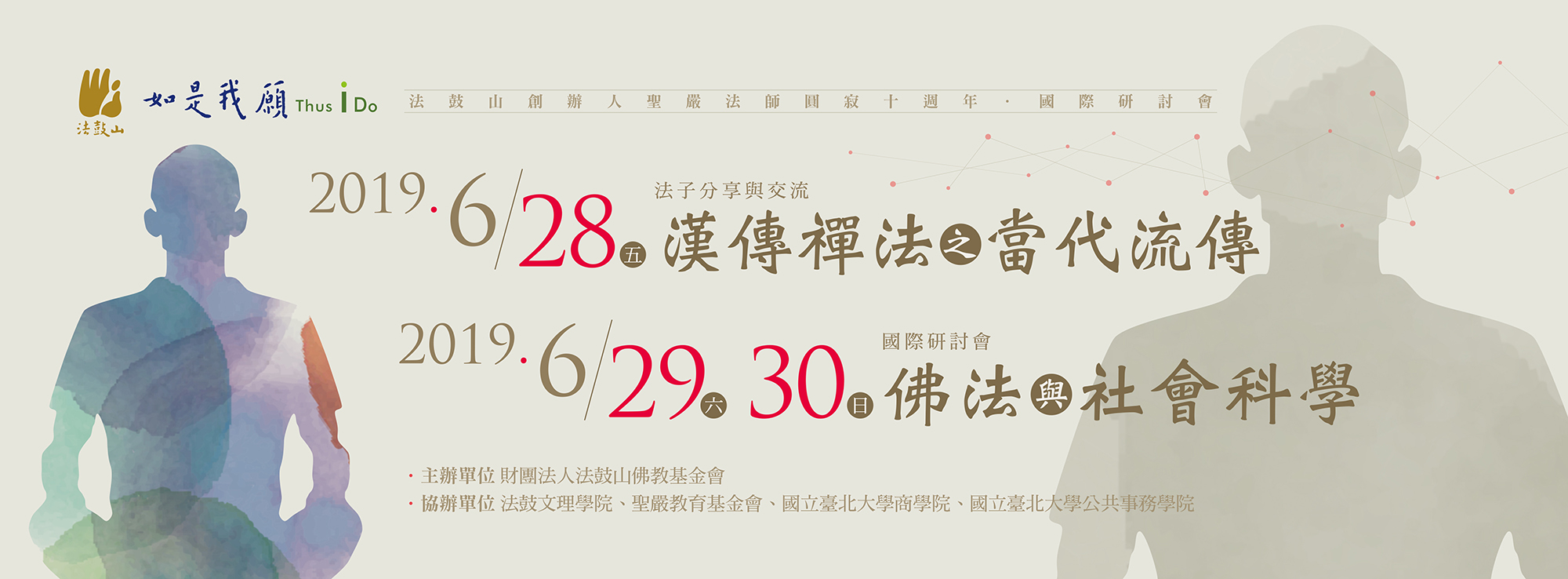佛學與法學平等觀的融合—以聖嚴法師的佛學詮釋為線索
朱麗亞
聖嚴法師的佛學詮釋重在生活實踐,法律學亦屬實用之學,兩者似有融合之可能。聖嚴法師以「建設人間淨土」作為佛法的實踐方向,其「求同存異,尊重多元」之平等精神,與法律上的平等有諸多可比較處。本文探究佛法所強調之「平等觀」,以聖嚴法師的詮釋為輔,進而比較佛學「平等」與當代民主法治國家所謂「平等」之異同。盼能使法學與佛學之平等觀合流,至少達到不衝突的境地,或以「同體大悲」與「無緣大慈」的價值作為法律詮釋的視角。
探究佛學、法學間之融合可能,之所以重要,正如同佛法與其他社會科學間之密切關聯。本文首先指出法學本質上的盲點,即「過多的分別」。傳統的法學方法,在於詳盡地就「利益歸屬主體」分門別類,以賦予利益或課與不利益,其「分別」的界線取決於世俗的、多數決的視角,以促成「實質平等」。然而,聖嚴法師所強調的理念:「把許多的『差異性利益』,匯歸於全地球、全人類永續的『共同性利益』。」儼然趨向光譜的另一端,係將各方利益殊途同歸。
面對世間的種種利益,法學力圖「區分」並「分配」之,佛法則強調「相即不二」與「平等共感」,兩者立場乍視衝突。故本文將解決的議題依序為:首先思考,佛法與法學如何可能相會?社會公義與和諧攸關「全人類」的共同利益,一味寄託於一國之法,效益有其極限,凡事依「法規範」固然是文明社會的必要條件,然什麼樣的「法與真理」,方是今日全球公民當歸依的方向?又,世俗規則(例如法學的平等)或許指向公義與和諧,不當然即合乎究竟真理(佛學平等觀),在世俗語言的框架下,法學理論與佛教倫理或有扞格,則佛法之「平等」如何善巧地與法學「平等」相互融合?
關鍵詞:平等、聖嚴法師、佛學、法學
Fusion of “Equality” under the Dharma and National Laws: from Master Sheng-Yen’s Interpretation of Buddhism
Li-Ya Chu
Master Sheng-Yen emphasises daily practice of Buddhist values while National Laws and Legal Theory should also be applied on a daily basis. Therefore, there seems to be the possibility for a fusion of these two areas. Interpretation of Buddhism emphasizes daily practice. State Laws or Legal Theory as a social science also focus on the study of practice. There seems a possibility for fusion of the above fields. Master Sheng-Yen regarded “Construction of the Pure Land on Earth” as the guideline for Dharma practices. The spirit of Dharma Equality which “seeks common ground while reserving differences” has several comparisons with Equality under the Law (Legal Theory). In this paper, the viewpoint of Equality under the Dharma will be based on Master Sheng-Yen’s interpretation of Buddhism. The comparisons will be made regarding Dharma Equality and the Right to Equality, and the Principle of Equality in contemporary democratic liberal politics. I wish to make confluence between “Equality” under the Dharma and the Legal Theory or, at the very least to establish that the two are not contradictory by means of legal interpretation according to the value of “unconditional compassion.”
Researching the capacity of fusion between Buddhism and Laws (Legal Theory) is as important as the relevance between Buddhism and the other social sciences. At the beginning of this paper, I will describe the main disadvantage of Legal Theory as having “too many criteria.” Which is because the purpose of traditional legal theory is to classify the interest-holders, and to distribute the interests and non-interests. The criteria all come from a secular and majority point of view, in order to achieve the so called "substantive equality." However, Master Sheng-Yen emphasized “integrate as many different interests into Buddhist practices to become the common interests of global citizens and of all human beings.” Compared with Legal Theory, this is a method almost completely opposite: to reach the same goal by different means from different interests.
To settle all kinds of interests on earth, Legal Theory aims to separate and distribute. On the other hand, Buddhist Dharma focuses on Inter-being and Equality based on Compassion. The above seem contradictory. Therefore, this paper will attempt to solve the following three issues: Firstly, it will discuss the possibility of fusion between Buddhism and Legal Theory. Secondly, because social justice and peace are relevant to the interests of all the human beings, relying on National Laws (Legal Theory) alone is not enough as their effect is limited. Although State Laws are what the modern world uses a more important question is: what kind of Dharma Laws and Truths should global citizens nowadays take refuge in? The last but not the least issue is concerned with secular regulations – including Equality under the Law- which may be aimed at justice and peace, but which is not exactly Ultimate Truth or Equality under the Dharma. In this world full of conventional language, Laws sometimes do not comply with the Dharma. Through the use of which skills and means can we integrate Buddhism and Legal Theory together?
